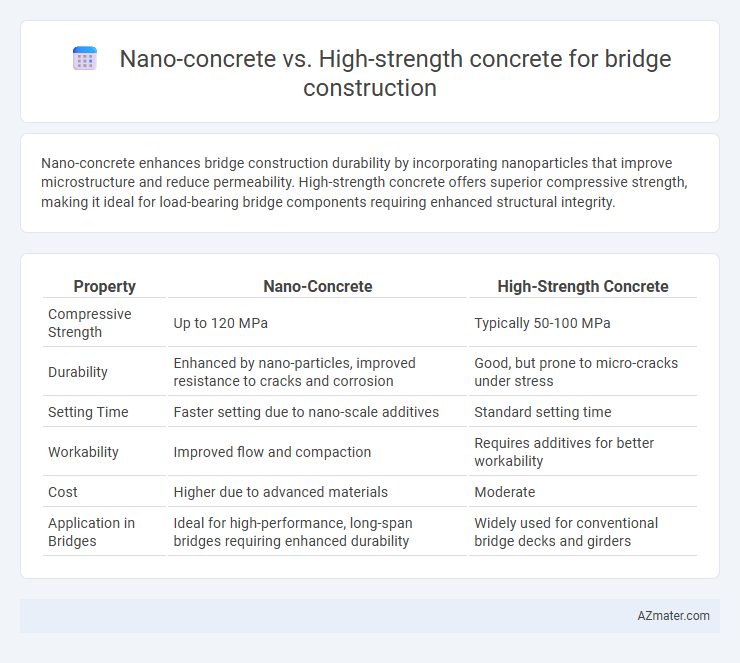Nano-concrete enhances bridge construction durability by incorporating nanoparticles that improve microstructure and reduce permeability. High-strength concrete offers superior compressive strength, making it ideal for load-bearing bridge components requiring enhanced structural integrity.
Table of Comparison
| Property | Nano-Concrete | High-Strength Concrete |
|---|---|---|
| Compressive Strength | Up to 120 MPa | Typically 50-100 MPa |
| Durability | Enhanced by nano-particles, improved resistance to cracks and corrosion | Good, but prone to micro-cracks under stress |
| Setting Time | Faster setting due to nano-scale additives | Standard setting time |
| Workability | Improved flow and compaction | Requires additives for better workability |
| Cost | Higher due to advanced materials | Moderate |
| Application in Bridges | Ideal for high-performance, long-span bridges requiring enhanced durability | Widely used for conventional bridge decks and girders |
Introduction to Nano-Concrete and High-Strength Concrete
Nano-concrete incorporates nanoparticles such as silica and titanium dioxide to enhance the microstructure and durability, resulting in superior mechanical properties and improved crack resistance compared to conventional concretes. High-strength concrete achieves compressive strengths typically above 40 MPa through optimized mix designs using high-quality materials and admixtures, offering increased load-bearing capacity essential for modern bridge construction. Both materials provide significant advancements in structural performance, with nano-concrete focusing on nanoscale enhancements and high-strength concrete emphasizing macroscopic strength improvements.
Material Composition: Nano vs High-Strength Concrete
Nano-concrete incorporates nanoparticles such as nano-silica and nano-titanium dioxide, enhancing cement hydration and refining microstructure for superior strength and durability. High-strength concrete typically relies on low water-to-cement ratios and high cement content with chemical admixtures to achieve compressive strengths exceeding 6000 psi. The nanomaterials in nano-concrete improve mechanical properties and crack resistance at a micro-scale, offering potential performance benefits over conventional high-strength mixtures in bridge construction.
Mechanical Properties Comparison
Nano-concrete exhibits superior mechanical properties compared to high-strength concrete, including enhanced compressive strength, increased tensile strength, and improved flexural capacity due to the effective dispersion of nanoparticles in the cement matrix. The incorporation of nanomaterials such as nano-silica leads to refined microstructure, resulting in reduced porosity and higher durability under tensile and shear stresses critical for bridge construction. High-strength concrete, while robust in compressive strength, often lacks the same level of toughness and crack resistance, making nano-concrete more advantageous for structural components requiring enhanced mechanical performance and longevity.
Durability and Longevity in Bridge Structures
Nano-concrete exhibits superior durability and longevity in bridge construction due to its enhanced nano-scale particle dispersion, which significantly improves resistance to micro-cracking and chemical attacks compared to high-strength concrete. The incorporation of nano materials reduces porosity and improves the interfacial transition zone, resulting in extended service life and reduced maintenance costs for bridge structures. High-strength concrete, while offering high load-bearing capacity, often suffers from brittleness and micro-crack susceptibility, making nano-concrete a more reliable choice for durable and long-lasting bridge applications.
Workability and Construction Methods
Nano-concrete improves workability through enhanced particle packing and reduced water demand, enabling smoother placement and finishing in bridge construction compared to high-strength concrete. High-strength concrete requires careful mix design with lower water-cement ratios and often employs superplasticizers to maintain workability without compromising strength. Construction methods using nano-concrete benefit from accelerated setting times and improved bonding properties, facilitating faster construction cycles and better durability in bridge infrastructure.
Cost Analysis and Economic Feasibility
Nano-concrete offers enhanced mechanical properties and durability at potentially lower material usage, which can reduce long-term maintenance costs in bridge construction compared to traditional high-strength concrete. Initial costs for nano-concrete are higher due to specialized nanoparticles and advanced mixing processes, but the extended lifespan and resistance to environmental degradation improve economic feasibility over time. High-strength concrete remains more cost-effective for projects with budget constraints and shorter design life requirements but may incur higher repair expenses in aggressive environments.
Environmental Impact and Sustainability
Nano-concrete incorporates nanoparticles that enhance durability and reduce permeability, leading to longer-lasting structures and decreased maintenance cycles, which significantly lowers the environmental footprint compared to traditional high-strength concrete. High-strength concrete, while providing excellent load-bearing capacity, generally requires higher cement content, resulting in greater CO2 emissions and energy consumption during production. The use of nano-concrete promotes sustainability by minimizing raw material usage and extending service life, making it a more eco-friendly choice for bridge construction projects focused on reducing greenhouse gas emissions and resource depletion.
Performance in Extreme Conditions
Nano-concrete exhibits superior durability and enhanced crack resistance compared to high-strength concrete, making it ideal for bridge construction in extreme conditions such as freeze-thaw cycles, corrosion, and seismic activity. Its nano-scale additives improve the microstructure, resulting in higher impermeability and strength retention under aggressive environmental stressors. High-strength concrete offers excellent compressive strength but may suffer from brittleness and reduced performance when exposed to extreme thermal or chemical exposures.
Case Studies of Bridge Applications
Case studies of bridge construction reveal that nano-concrete enhances durability and crack resistance by integrating nano-silica particles, significantly improving the microstructure compared to traditional high-strength concrete. Bridges utilizing nano-concrete demonstrate superior longevity and reduced maintenance costs, as observed in projects like the Nanotech Bridge in Japan and the Smart Bridge in China. High-strength concrete, while offering improved compressive strength, often lags behind nano-concrete in addressing long-term performance challenges such as chloride penetration and fatigue resistance.
Future Trends in Bridge Concrete Technology
Innovations in nano-concrete involve incorporating nanoparticles such as nano-silica, which enhance durability and crack resistance by refining the microstructure, making it a promising material for future bridge construction. High-strength concrete remains essential for supporting greater loads and longer spans, with ongoing research focusing on optimizing its composition for sustainability and resilience. Emerging trends emphasize hybrid approaches combining nano-enhanced additives with high-strength matrices to achieve superior mechanical properties and longevity in bridge infrastructure.

Infographic: Nano-concrete vs High-strength concrete for Bridge construction
 azmater.com
azmater.com